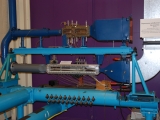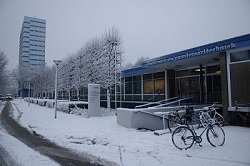ST-3 Supersonic windtunnel
The supersonic wind tunnel ST-3 is a small vacuum tunnel originally built as a research tool at NLR, Amsterdam. In fact, the ST-3 in its initial form was the very first supersonic wind tunnel in the Netherlands. In later years, an alternative test section was added as a pilot facility for the larger NLR wind tunnels. In 1969, the installation was donated to the university. In its present shape, both the pilot section (PST-3) and the research section (RST-3) may be used alternatively. A 36 kW vacuum pump allows continuous operation of the wind tunnel. The inherent safety and low noise level of a vacuum tunnel render the ST-3 particularly suitable for students' exercises, for which it is mainly used today. Its limitations lie in the tiny size of models and the low Reynolds number, causing viscous effects and early flow separation.
The PST-3 section has a continuously variable semiflexible nozzle (M from subsonic to 3.7). The working section is 34 mm wide; the average height, varying with the Mach number, is 25 mm. In spite of the small size of the working section, a pitching mechanism for sting-mounted models is available.
The alternative section RST-3 consists of a channel of rectangular section with glass sidewalls. A number of contour blocks is available to form nozzles of different shapes and Mach numbers, leading up to a working section of 30 mm square. The optical system is mounted on a separate frame that can be rolled along the length of the nozzle, test section and supersonic diffuser.
Typical research topics
This tunnel is mainly used for educational purposes. For second and third year students it is used as demonstration tunnel for compressible flows.

Overview of ST-3 wind tunnel
Location:

High Speed Lab
- +31 15 2789670
-
Kluyverweg 2
2629 HT Delft